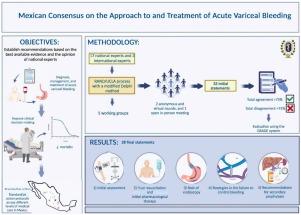Mexican consensus on the approach to and treatment of acute variceal bleeding
Revista de gastroenterologia de Mexico (English)
Pub Date : 2025-07-01
DOI:10.1016/j.rgmxen.2025.09.007
引用次数: 0
Abstract
Introduction and aims
Portal hypertension is the main consequence of cirrhosis and the cause of most of its complications, such as ascites, variceal bleeding, and hepatic encephalopathy. The development of those complications marks the transition from compensated cirrhosis to decompensated cirrhosis, and the latter is associated with poor prognosis. Approximately 50% of cirrhotic patients have gastroesophageal varices. Acute variceal bleeding (AVB) is a medical emergency with high mortality rates ranging from 15 to 25% within 6 weeks. AVB management has evolved in recent years due to new evidence on fluid resuscitation and transfusion support, advances in endoscopic techniques, esophageal stent use, and transjugular intrahepatic portosystemic shunt (TIPS) placement. This consensus aimed to establish recommendations based on the best available evidence and expert opinion from Mexican specialists in gastroenterology for the diagnosis, management, and treatment of AVB in patients with portal hypertension. The goal was to improve clinical decision-making, reduce the associated mortality, and standardize care protocols across the different levels of medical care in Mexico.
Material and methods
Seventeen national and 3 international experts were divided into five working groups to address five thematic areas: 1) initial evaluation, 2) fluid resuscitation and initial pharmacologic therapy, 3) the role of endoscopy, 4) strategies for managing failed bleeding control, and 5) secondary prophylaxis recommendations. The consensus was developed utilizing the RAND/UCLA process, with a modified Delphi method.
Results
A total of 28 statements were produced, with specific recommendations on initial fluid resuscitation and transfusion strategy, and highlighting the importance of vasopressor use, the role of endoscopy, and AVB prophylaxis.
Conclusions
This first Mexican Consensus on Acute Variceal Bleeding establishes practical recommendations for standardizing AVB management in patients with cirrhosis in Mexico, from the initial evaluation to secondary prophylaxis, emphasizing the importance of specific strategies and laying the groundwork for future research.

关于急性静脉曲张出血的方法和治疗的墨西哥共识。
简介和目的:门脉高压是肝硬化的主要后果,也是肝硬化大多数并发症的原因,如腹水、静脉曲张出血和肝性脑病。这些并发症的发生标志着代偿性肝硬化向失代偿性肝硬化的转变,而失代偿性肝硬化与预后不良有关。大约50%的肝硬化患者有胃食管静脉曲张。急性静脉曲张出血(AVB)是一种医疗紧急情况,6周内死亡率高,从15%到25%不等。近年来,由于液体复苏和输血支持的新证据、内窥镜技术的进步、食管支架的使用和经颈静脉肝内门静脉系统分流术(TIPS)的放置,AVB的管理已经发生了变化。该共识旨在根据墨西哥胃肠病学专家的最佳现有证据和专家意见,对门静脉高压症患者的AVB的诊断、管理和治疗提出建议。其目标是改善临床决策,降低相关死亡率,并使墨西哥不同医疗水平的护理方案标准化。材料和方法:17名国内专家和3名国际专家被分成5个工作组,讨论5个主题领域:1)初步评估,2)液体复苏和初始药物治疗,3)内窥镜检查的作用,4)管理出血控制失败的策略,5)二级预防建议。共识是利用兰德/加州大学洛杉矶分校的过程,用改进的德尔菲法开发的。结果:共产生了28份声明,对初始液体复苏和输血策略提出了具体建议,并强调了血管加压剂使用的重要性、内窥镜检查的作用和AVB预防。结论:这是墨西哥第一个关于急性静脉曲张出血的共识,为墨西哥肝硬化患者AVB管理的标准化提出了实用建议,从初步评估到二级预防,强调了具体策略的重要性,并为未来的研究奠定了基础。
本文章由计算机程序翻译,如有差异,请以英文原文为准。
求助全文
约1分钟内获得全文
求助全文

 求助内容:
求助内容: 应助结果提醒方式:
应助结果提醒方式:


